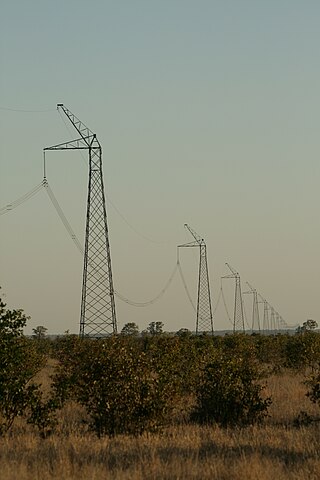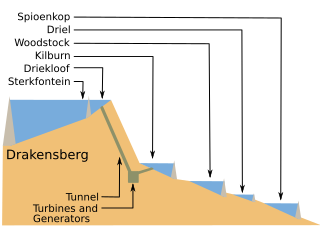Related Research Articles
Eskom Hld SOC Ltd or Eskom (Afrikaans: Elektrisiteitsvoorsieningskommissie) is a South African electricity public utility. Eskom was established in 1923 as the Electricity Supply Commission (ESCOM). Eskom represents South Africa in the Southern African Power Pool. The utility is the largest producer of electricity in Africa, and was among the top utilities in the world in terms of generation capacity and sales. It is the largest of South Africa's state owned enterprises. Eskom operates a number of notable power stations, including Matimba Power Station and Medupi Power Station in Lephalale, Kusile Power Station in Witbank, Kendal Power Station, and Koeberg Nuclear Power Station in the Western Cape Province, the only nuclear power plant in Africa.

Nalubaale Power Station, formerly known as Owen Falls Dam, is a hydroelectric power station across the White Nile near its source at Lake Victoria in Uganda. Nalubaale is the Luganda name for Lake Victoria.

Cahora-Bassa is an separate bipolar HVDC power transmission line between the Cahora Bassa Hydroelectric Generation Station at the Cahora Bassa Dam in Mozambique, and Johannesburg, South Africa.
Sunninghill is a commercial and residential suburb of Sandton in Gauteng, South Africa. It is located in Region A of the City of Johannesburg Metropolitan Municipality. The N1 freeway, which at this area is eight lanes across, forms its southern boundary with access at Rivonia offramp. The K60 road runs through the centre of Sunninghill to assist in easing traffic. Sunninghill is bordered by the suburbs of Paulshof, Kyalami and Woodmead.

The Palmiet Pumped Storage Scheme consists of two 200 megawatts (270,000 hp) turbine units located 2 kilometres (1.2 mi) upstream of the Kogelberg Dam on the Palmiet River near Cape Town, South Africa. The pumped-storage hydroelectricity plant is capable of responding to a surge in peak power demand in minutes. At night, excess power on the grid generated by conventional coal and nuclear plants is used to pump water to the upper Rockview Dam overlooking Gordon's Bay.
Grootvlei Power Station is a coal-fired power station located in Grootvlei, Mpumalanga, South Africa.
Zimbabwe Electricity Supply Authority, (ZESA) whose official name is ZESA Holdings (Private) Limited, is a state-owned company whose task is to generate, transmit, and distribute electricity in Zimbabwe.
The Ingula Pumped Storage Scheme is a pumped-storage power station in the escarpment of the Little Drakensberg range straddling the border of the KwaZulu-Natal and Free State provinces, South Africa. It is about 22 km (14 mi) North-East of Van Reenen.

Driekloof Dam is a small section of the Sterkfontein Dam, Free State, South Africa. A section of the Sterkfontein Dam reservoir is isolated after the construction of Driekloof Dam, this small reservoir has a capacity of 35.6 million cubic metres (28,900 acre⋅ft)., together with the Kilburn Dam almost 500 metres (1,600 ft) lower, Driekloof forms part of Eskom's Drakensberg Pumped Storage Scheme and Tugela-Vaal Water Project, and provides for up to 27.6 gigawatt-hours (99 TJ) of electricity storage in the form of 275 million cubic metres of water. The water is pumped to Driekloof during times of low national power consumption and released back into Kilburn through four 250 megawatts (340,000 hp) turbine generators in times of high electricity demand.

The Drakensberg Pumped Storage Scheme is an energy storage facility built in the South African provinces of Free State and KwaZulu-Natal starting in 1974 and completed by 1981.

Kiira Hydroelectric Power Station, is a hydroelectric power station in Uganda, with an installed capacity of 200 megawatts (270,000 hp).
Electricity Supply Corporation of Malawi Limited (ESCOM) is the state-owned power transmission and distribution company in Malawi. It is entirely in control of transmission and distribution of electric power in the country. ESCOM represents Malawi in the Southern African Power Pool. It should not be confused with its South African equivalent Eskom.
South Africa has a large energy sector, being the third-largest economy in Africa. The country consumed 227 TWh of electricity in 2018. The vast majority of South Africa's electricity was produced from coal, with the fuel responsible for 88% of production in 2017. South Africa is the 7th largest coal producer in the world. As of July 2018, South Africa had a coal power generation capacity of 39 gigawatts (GW). South Africa is the world's 14th largest emitter of greenhouse gases. South Africa is planning to shift away from coal in the electricity sector and the country produces the most solar and wind energy by terawatt-hours in Africa. The country aims to decommission 34 GW of coal-fired power capacity by 2050. It also aims to build at least 20 GW of renewable power generation capacity by 2030. South Africa aims to generate 77,834 megawatts (MW) of electricity by 2030, with new capacity coming significantly from renewable sources to meet emission reduction targets. Through its goals stated in the Integrated Resource Plan, it announced the Renewable Energy Independent Power Producer Procurement Programme, which aims to increase renewable power generation through private sector investment.

Solar power in South Africa includes photovoltaics (PV) as well as concentrated solar power (CSP). As of 2023, South Africa had over 2700 MW of installed PV solar power capacity in its grid, in addition to 500 MW of CSP. Installed capacity is expected to reach 8,400 MW by 2030.

Kusile Power Station in South Africa is a coal-fired power plant by state electricity utility Eskom in Mpumalanga. The station consists of 6 generating units with an eventual nameplate capacity of 800 MW each bringing the total installed capacity of 4,800 MW.
The Uganda Electricity Generation Company Limited (UEGCL) is a parastatal company whose primary purpose is to generate electric power for use in Uganda and for sale to neighboring countries. As of December 2017, UEGCL's generation capacity was 380 megawatts, with that capacity planned to increase to over 1,300 megawatts, by 2023.
Eskom Uganda or Eskom Uganda Limited (EUL) is the largest generator of energy in Uganda and was incorporated in 2002 for a 20 year concession under a government regulatory framework.

South Africa’s energy crisis or load shedding is an ongoing period of widespread national blackouts of electricity supply. It began in the later months of 2007 towards the end of Thabo Mbeki's second term as president, and continues to the present. The South African government-owned national power utility, and primary power generator, Eskom, and various parliamentarians attributed these rolling blackouts to insufficient generation capacity.
The Prieska–Total Solar Power Station, also Mulilo Prieska Solar Power Station, is an 86 megawatts solar power plant in South Africa. The solar farm was developed and is owned by a consortium comprising five independent power producers (IPPs), development finance companies and private investment firms. The power station owners formed a special purpose vehicle (SPV) company called Mulilo Prieska PV (RF), to design, finance, construct, own, operate and maintain the power station and related infrastructure. The off-taker of the energy generated here is Eskom Holdings, the public electricity utility parastatal of South Africa. A 20-year power purchase agreement between Murillo Prieska PV and Eskom, governs the sale and purchase of electricity between the power station and the electric utility.
References
- ↑ Luvhengo, Phathu (12 November 2021). "WATCH: Fed-up residents protest outside Eskom's Megawatt Park". Fourways Review.
- ↑ Motloung, Tshepiso (2 February 2023). "Electricity tariff hike: Residents, civil society organisations march to Eskom's Megawatt Park". News24.